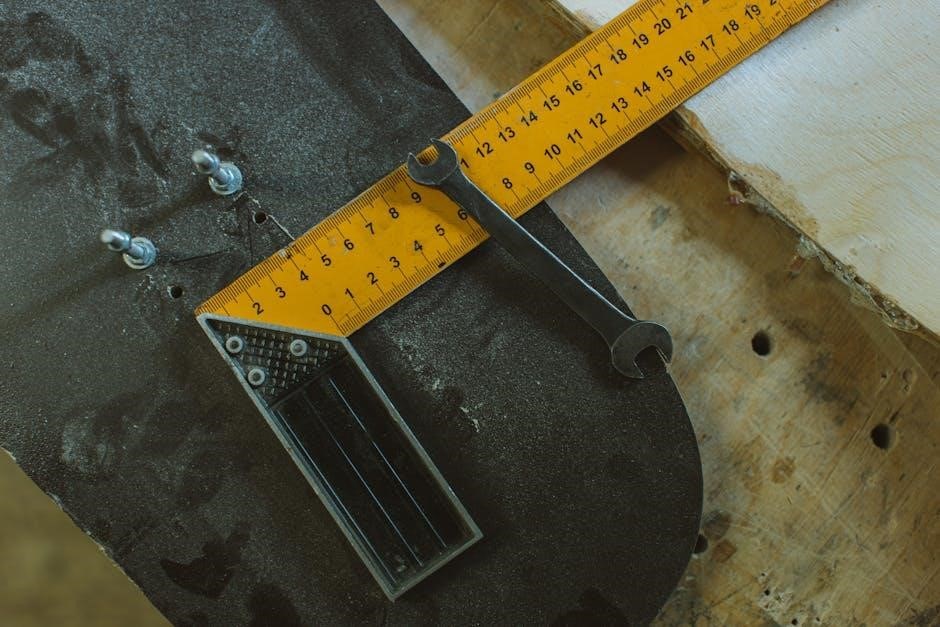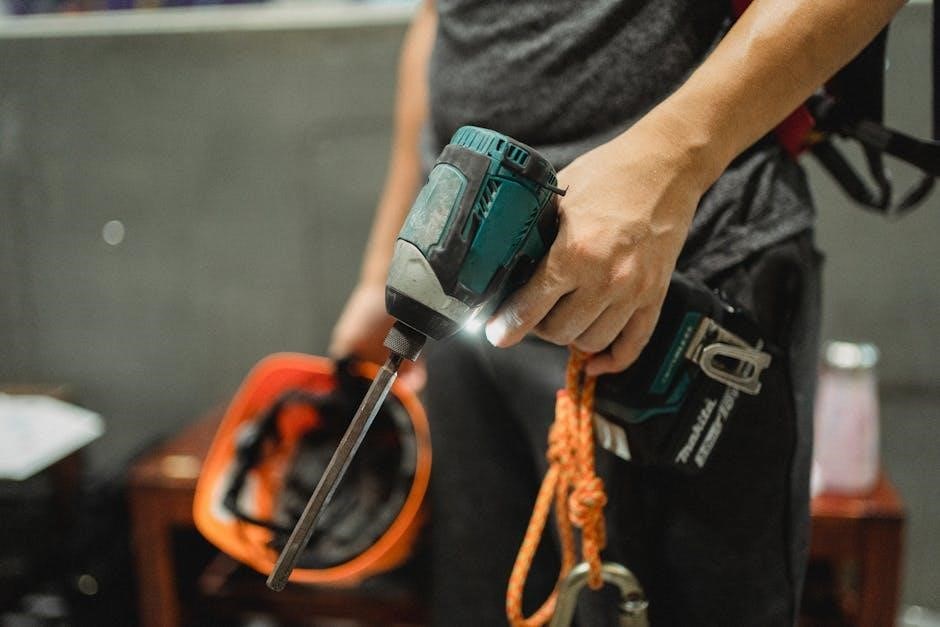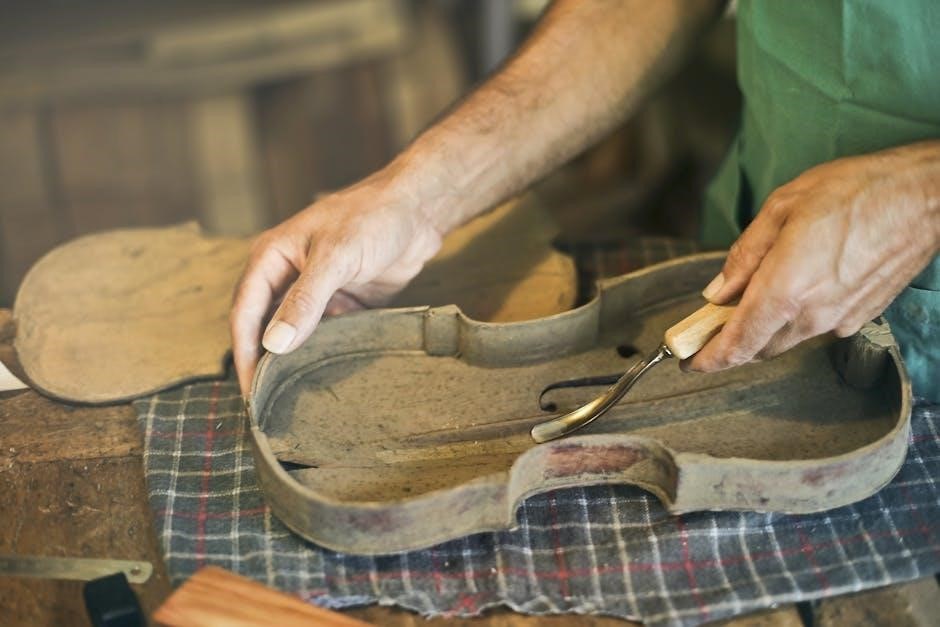The Cessna 100 Series Maintenance Manual is a comprehensive guide for ensuring the airworthiness and safety of Cessna 100 Series aircraft. It provides detailed procedures for routine inspections, repairs, and upgrades. This manual is essential for aircraft owners, mechanics, and pilots to maintain compliance with aviation standards and ensure reliable performance. Regular maintenance is critical for extending the aircraft’s lifespan and preventing costly repairs.

Understanding the Cessna 100 Series Maintenance Manual
The Cessna 100 Series Maintenance Manual is a detailed document designed to guide owners, mechanics, and pilots in maintaining the airworthiness of Cessna 100 Series aircraft. It covers a wide range of topics, from routine inspections to complex repairs, ensuring compliance with aviation regulations. The manual is structured to provide clear, step-by-step instructions for both novice and experienced users. Key sections include pre-flight checks, airframe maintenance, engine care, and avionics systems. It emphasizes safety, highlighting critical procedures to prevent accidents and extend the aircraft’s lifespan. Regular updates ensure the manual aligns with the latest aviation standards and technological advancements. By following its guidelines, users can ensure optimal performance, reliability, and safety. Proper use of the manual is essential for maintaining compliance with aviation authorities and preventing costly repairs. Its comprehensive approach makes it an indispensable resource for anyone involved in the upkeep of Cessna 100 Series aircraft.

Pre-Flight Checks
Pre-flight checks are crucial for ensuring the Cessna 100 Series aircraft is airworthy. The manual outlines a systematic approach, covering visual inspections, control surface functionality, and system verifications. These checks help identify potential issues before takeoff, enhancing safety and reducing the risk of in-flight complications. Regular adherence ensures compliance with maintenance standards.
3.1 Daily Inspections
Daily inspections are a critical component of maintaining the airworthiness of the Cessna 100 Series aircraft. These checks ensure that the aircraft is safe for flight and free from any potential issues that could lead to operational failures. The maintenance manual outlines specific procedures for these inspections, which should be conducted systematically and thoroughly.

- Exterior Inspection: Begin by examining the aircraft’s exterior, paying attention to the wings, fuselage, and landing gear. Look for signs of damage, wear, or corrosion. Ensure all control surfaces are properly secured and functioning correctly. Check tire pressure and brake condition, as these are vital for safe takeoff and landing.
- Interior Inspection: Inside the cockpit, inspect all instruments and avionics systems for proper function. Verify that all warning lights and indicators are operational. Check seatbelts and harnesses for wear or damage. Ensure that all necessary flight documents, such as the aircraft’s registration and maintenance logs, are onboard and up to date.
- Control Surfaces: Test the ailerons, elevators, and rudder for smooth operation and proper alignment. Ensure that all control locks are removed and that the flight controls are free from obstructions. Any irregularities in movement or alignment should be addressed immediately.
These daily inspections are designed to identify and address potential issues before they escalate. By following the guidelines in the Cessna 100 Series Maintenance Manual, operators can ensure the aircraft remains in optimal condition and ready for safe flight operations.
3.2 Flight Control Surfaces
The flight control surfaces of the Cessna 100 Series aircraft are essential for maintaining stability and control during flight. These include the ailerons, elevators, and rudder, which must be regularly inspected and maintained to ensure proper function. The maintenance manual provides detailed procedures for inspecting these surfaces, emphasizing the importance of their condition and alignment.
- Ailerons: These are located on the trailing edges of the wings and are responsible for roll control. During inspection, ensure that all hinges and attachment points are secure and free from wear. Check for any signs of damage or delamination, as these could affect roll response and overall handling.
- Elevators: Positioned at the rear of the aircraft, the elevators control pitch. Inspect for proper alignment and movement, ensuring that the elevator trim is functioning correctly. Any misalignment or play in the hinges can lead to unpredictable pitch behavior during flight.
- Rudder: Located on the vertical stabilizer, the rudder provides yaw control. Check for smooth operation and ensure that all control cables are properly secured and free from damage. The rudder’s condition is crucial for maintaining directional control, especially during takeoff and landing.
The manual also outlines procedures for balancing and rigging the control surfaces to ensure optimal performance. Any discrepancies found during these inspections should be addressed promptly by a qualified technician. Regular maintenance of the flight control surfaces is vital for the safety and reliability of the aircraft.
3.3 Landing Gear Inspection
The landing gear system of the Cessna 100 Series is a critical component that ensures safe takeoffs, landings, and ground operations. Regular inspections are essential to identify potential issues before they escalate. The maintenance manual outlines specific procedures for inspecting the landing gear, including the tires, brakes, oleo struts, and associated linkages.
- Tires: Check for proper inflation, tread wear, and signs of damage such as cuts, bulges, or uneven wear. Ensure the tire pressure matches the recommendations in the manual to maintain optimal performance and safety.
- Brakes: Inspect the brake pads for wear and ensure the braking system functions correctly. Look for any leaks in the hydraulic lines or cylinders, as these can lead to reduced braking efficiency.
- Oleo Struts: These components absorb shock during landing. Check for any signs of leakage or damage to the seals. Ensure the struts are properly extended and function smoothly during ground tests.
- Linkages and Fasteners: Examine all moving parts and connections for wear, corrosion, or looseness. Tighten any loose bolts or nuts and replace damaged components immediately.
Additionally, the manual recommends testing the landing gear’s retraction and extension mechanisms if applicable. Hydraulic fluid levels should also be checked and topped off as needed. Any irregularities or damage found during these inspections must be addressed promptly by a qualified technician to ensure the aircraft remains airworthy. Regular maintenance of the landing gear system is vital for preventing accidents and ensuring the safety of both the aircraft and its occupants.

Airframe Maintenance
Regular airframe maintenance is crucial for ensuring the structural integrity and longevity of the Cessna 100 Series aircraft. This involves thorough inspections to detect wear, corrosion, or damage. Cleaning and protecting surfaces prevent deterioration. Adhering to the manufacturer’s guidelines ensures all components remain in optimal condition, preventing potential issues from escalating into major repairs.
4.1 Structural Integrity Checks
Structural integrity checks are a critical component of the Cessna 100 Series maintenance process, ensuring the aircraft’s airframe remains robust and safe for flight. These checks involve a thorough inspection of the airframe, wings, fuselage, and control surfaces for signs of damage, corrosion, or wear. Inspectors must pay close attention to high-stress areas, such as joints, rivets, and welds, where fatigue or corrosion is most likely to occur.
One key aspect of structural integrity checks is the identification of any unauthorized modifications or repairs that may compromise the aircraft’s original design specifications. The maintenance manual outlines specific procedures for assessing the condition of load-bearing components, such as wing spars and engine mounts, to ensure they can withstand operational stresses.
In addition to visual inspections, advanced techniques like ultrasonic testing or eddy-current inspections may be employed to detect hidden damage or internal corrosion. Any findings must be documented and addressed promptly, with repairs performed in accordance with the manual’s guidelines to maintain airworthiness.
Regular structural checks also help identify potential issues before they escalate, preventing costly repairs and ensuring the aircraft’s longevity. By adhering to the Cessna 100 Series Maintenance Manual’s recommendations, maintenance professionals can safeguard the structural integrity of the aircraft, ultimately contributing to safer and more reliable flights.
Lastly, all structural inspections must be recorded in the aircraft’s maintenance log, providing a clear history of inspections and repairs for future reference. This systematic approach ensures compliance with aviation standards and supports the overall safety of the aircraft and its occupants.
4.2 Skin and Surface Repair
Skin and surface repair is a vital aspect of maintaining the Cessna 100 Series aircraft, ensuring its aerodynamic efficiency and structural integrity. The process involves inspecting and addressing damage to the aircraft’s exterior surfaces, including dents, scratches, and corrosion. Even minor imperfections can lead to significant issues if left unattended, such as increased drag or compromised safety.
The maintenance manual provides detailed guidelines for assessing and repairing skin damage. For aluminum alloy surfaces, common repair techniques include metalworking, such as smoothing out dents or replacing damaged panels. Corrosion must be carefully removed and treated to prevent further deterioration. Repainting or applying protective coatings is also essential to maintain the aircraft’s finish and protect it from environmental factors.

Technicians must use approved materials and tools to ensure repairs meet aviation standards. For instance, specialized rivets and sealants are recommended to maintain airworthiness. The manual also emphasizes the importance of documenting all repairs, including before-and-after inspections, to ensure transparency and compliance with safety regulations.
Regular maintenance and prompt repairs help prevent minor issues from escalating into major problems. By following the Cessna 100 Series Maintenance Manual’s instructions, technicians can ensure the aircraft’s surfaces remain in optimal condition, contributing to its overall performance and longevity.
Ultimately, meticulous attention to skin and surface repair is crucial for safeguarding the aircraft’s integrity and ensuring safe, reliable operation. Adherence to the manual’s guidelines guarantees that repairs are both effective and compliant with industry standards.

Engine Maintenance
Engine maintenance is critical for ensuring the Cessna 100 Series aircraft operates safely and efficiently. The manual outlines procedures for routine inspections, oil changes, and cooling system checks. Proper maintenance prevents overheating, corrosion, and wear on engine components. Adhering to the manual’s guidelines ensures optimal performance, reduces the risk of engine failure, and extends service life.
5.1 Oil and Filter Changes
Regular oil and filter changes are critical for maintaining the health and performance of the Cessna 100 Series aircraft engine. The manual specifies the recommended oil types and filter replacements to ensure optimal engine lubrication and contamination prevention. Pilots and mechanics must adhere to the prescribed schedule, typically every 50 hours of flight time, to avoid premature wear on engine components.
The process begins with warming up the engine to ensure the oil is viscous and drains easily. Using approved tools, the oil drain plug is removed, and the old oil is collected in a suitable container. The oil filter is then carefully removed and replaced with a new one, ensuring no debris enters the engine. Fresh oil is added, and the system is checked for leaks before restarting the engine.
Proper disposal of used oil and filters is emphasized to comply with environmental regulations. Detailed steps in the manual guide users through each procedure, ensuring safety and compliance. Regular oil and filter changes are vital for maintaining engine integrity and preventing costly repairs. Always refer to the Cessna 100 Series Maintenance Manual for specific guidelines and recommendations tailored to your aircraft model.
5.2 Cooling System Maintenance
Cooling system maintenance is essential for ensuring the Cessna 100 Series aircraft operates within safe temperature ranges. The manual outlines procedures for inspecting and maintaining the cooling system components, including the radiator, hoses, and coolant levels. Regular checks help prevent overheating, which can lead to engine damage and costly repairs.
The cooling system should be inspected every 50 hours of flight time or as specified in the maintenance manual. This includes checking the coolant level, ensuring it meets the recommended specifications for the aircraft model. The radiator should be cleaned periodically to remove any debris or corrosion that could impede airflow and reduce cooling efficiency.
Hoses and connections must be examined for signs of wear, cracks, or leaks. Any damaged components should be replaced immediately to prevent coolant loss and potential engine failure. The manual also provides guidance on bleeding the cooling system to eliminate air pockets, which can disrupt proper coolant circulation.
Additionally, the manual recommends specific coolants that are compatible with the aircraft’s materials and operating conditions. Proper mixing ratios and storage guidelines are outlined to ensure the coolant remains effective and does not degrade over time. Regular maintenance of the cooling system is crucial for maintaining engine performance and longevity.
By following the Cessna 100 Series Maintenance Manual’s cooling system procedures, pilots and mechanics can ensure reliable engine operation and prevent overheating-related issues. Adhering to these guidelines is vital for the safety and efficiency of the aircraft.
5.3 Spark Plug Maintenance
Spark plug maintenance is a critical component of engine upkeep for the Cessna 100 Series aircraft. The manual provides detailed procedures for inspecting, cleaning, and replacing spark plugs to ensure optimal engine performance. Properly maintained spark plugs are essential for efficient fuel combustion, consistent power delivery, and minimizing engine wear.
The manual recommends removing the spark plugs at regular intervals, typically every 100 hours of operation or as specified in the maintenance schedule. During removal, care must be taken to prevent damage to the spark plug wells or threads. Inspect each plug for signs of wear, fouling, or damage. Fouled spark plugs may indicate issues with the fuel-air mixture or ignition system.
Cleaning spark plugs should be done carefully to avoid damaging the ceramic insulator or the metal electrode. If a spark plug is damaged or excessively worn, it must be replaced. The manual specifies the correct torque values for installing new spark plugs to ensure proper seating and sealing. Incorrect torque can lead to engine damage or poor performance.
The Cessna 100 Series Maintenance Manual also outlines the importance of using spark plugs with the correct heat range and configuration for the aircraft’s engine. Improper spark plugs can lead to detonation, reduced fuel efficiency, or engine misfires. Regular spark plug maintenance is vital for maintaining reliable engine operation and extending the service life of the aircraft.
By following the manual’s guidelines, pilots and mechanics can ensure the engine runs smoothly, delivering consistent power and performance during flight. Proper spark plug maintenance is a cornerstone of overall aircraft reliability and safety.

Avionics and Electrical Systems

The Cessna 100 Series Maintenance Manual dedicates a section to avionics and electrical systems, emphasizing proper inspection and maintenance. Key components include communication, navigation, and electrical power systems. Regular checks on circuit breakers, wiring, and connectors are essential to ensure reliable operation. Troubleshooting common issues like short circuits or faulty avionics components is also covered.
6.1 System Overview
The avionics and electrical systems of the Cessna 100 Series are designed to provide reliable communication, navigation, and electrical power to support safe and efficient flight operations. These systems include components such as radios, GPS units, autopilot systems, and circuit breakers. The electrical system powers all avionics equipment, ensuring proper functionality during flight. Regular maintenance is crucial to prevent system failures and ensure compliance with aviation standards.
The avionics system integrates various subsystems, including navigation aids like VOR and GPS, communication radios for pilot-to-air traffic control interactions, and instruments that monitor flight parameters. The electrical system, powered by an alternator and battery, distributes power to these components. Proper grounding and wiring are essential to avoid malfunctions and electrical interference. The Cessna 100 Series maintenance manual provides detailed procedures for inspecting and testing these systems.
Understanding the system layout and functionality is vital for troubleshooting and maintenance. The manual emphasizes the importance of following manufacturer guidelines to ensure system reliability. By adhering to these procedures, aircraft owners and mechanics can maintain optimal performance and safety of the avionics and electrical systems. This section serves as a foundation for more detailed maintenance tasks outlined in subsequent sections. Regular checks and updates are necessary to keep the systems operational and compliant with current aviation regulations.
6.2 Circuit Breakers and Wiring
The circuit breakers and wiring systems in the Cessna 100 Series are critical components of the aircraft’s electrical infrastructure. Circuit breakers are designed to protect electrical circuits from overcurrent conditions, ensuring the system remains operational and safe during flight. Regular inspections of these components are essential to identify and address potential issues before they lead to system failures.
The wiring system is the backbone of the aircraft’s electrical network, connecting avionics, lights, and other essential systems. Proper maintenance involves checking for signs of wear, corrosion, or damage to the wires and connectors. Any discrepancies must be addressed promptly to prevent electrical malfunctions. The Cessna 100 Series maintenance manual provides detailed procedures for testing circuit breakers and inspecting wiring harnesses.

Circuit breakers should be tested periodically to ensure they function correctly under overload conditions. If a circuit breaker trips frequently, it may indicate an underlying issue such as a short circuit or excessive current draw. The wiring system must also be verified for proper connections and insulation integrity. Improper wiring practices can lead to electrical fires or system failures, posing significant safety risks.
Additionally, the manual emphasizes the importance of using approved materials and tools when performing repairs or modifications to the wiring system. Circuit breaker panels should be inspected for cleanliness and proper alignment to ensure reliable operation. By adhering to these maintenance guidelines, aircraft owners and technicians can ensure the electrical system operates safely and efficiently. Regular checks and proactive maintenance are key to preventing unexpected issues during flight.



